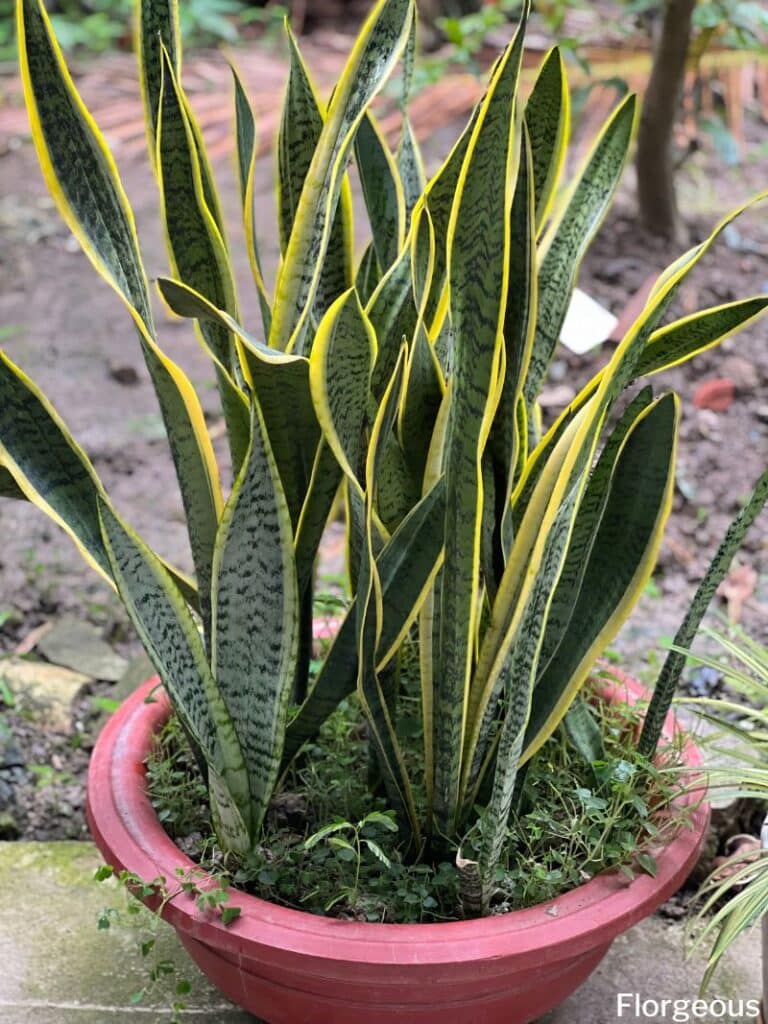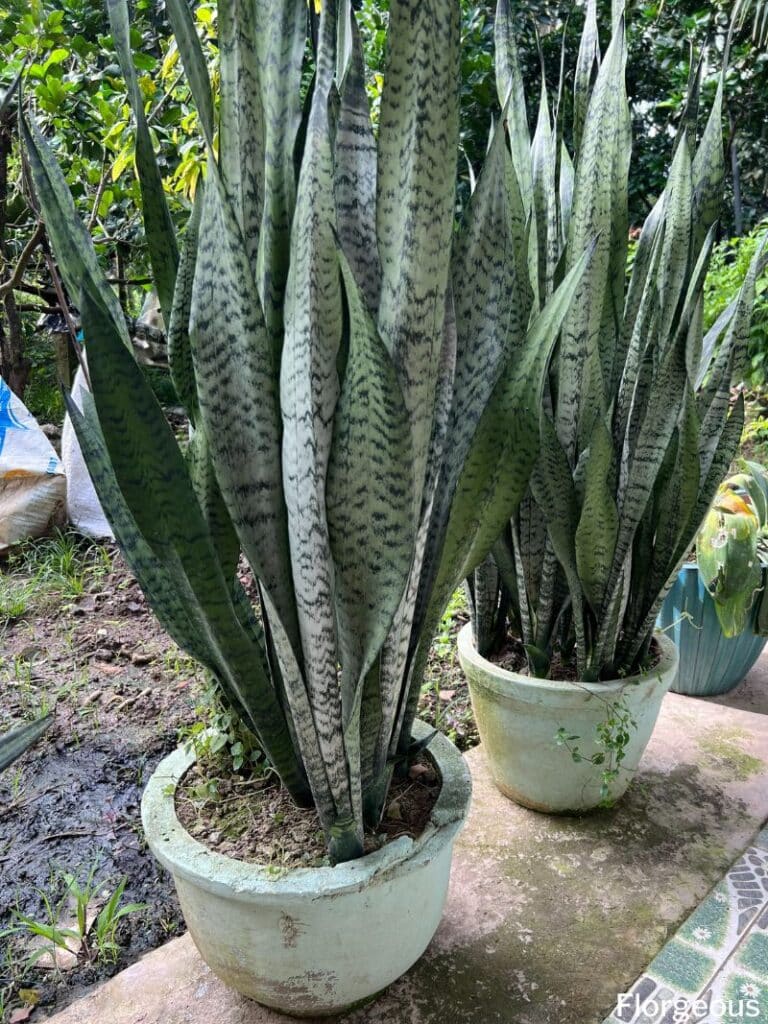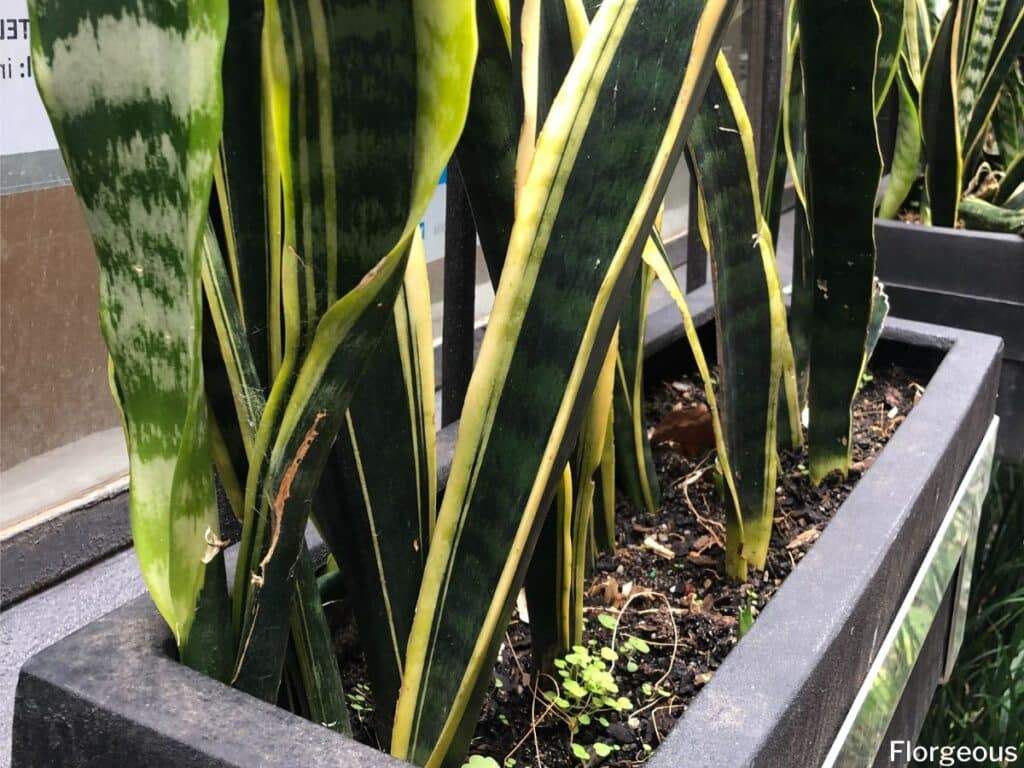The snake plant, (also known as mother-in-law’s tongue plant, Dracaena trifasciata or Sansevieria trifasciata), is a popular choice among indoor and outdoor gardeners alike.
This beautiful plant not only adds an aesthetic touch to your living or work space, but it is also known to be hardy and easy to maintain.
It’s no wonder why so many choose to keep the snake plant around, but what do you do when the leaves on your snake plant begin to yellow?
First and foremost, there is no need to panic if the leaves on your snake plant begin to yellow.
Yellowing leaves are generally caused by something as simple as overwatering your plant, and while there are other possibilities, there are several solutions. If you have a snake plant that is starting to look like it has seen better days, read on!
Why Is My Snake Plant Turning Yellow?
Here are a few common reasons behind yellow snake plant leaves.
Water Issues
If you notice the leaves on your Sansevieria plant beginning to yellow, the first thing you should consider is if you might be overwatering your snake plant.
Many plant owners take great care in watering their plants frequently, and while many plants appreciate this, it may cause harm to your snake plant.
Overwatering often leads to root rot, a fungal disease that can make it difficult for the plant’s roots to absorb needed nutrients and water.
Insect Problems
If you find that you are watering your snake plant appropriately but the leaves are still yellowing, you may have a small pest issue.
Insects are a common problem for many plant owners, even with plants that are kept indoors.
Pests will generally cause stress on a plant, and while different plants will show stress differently, yellowing leaves are the most common symptom for a stressed snake plant. While there are several potential pests, some common culprits include aphids, spider mites, mealybugs, and thrips.

Potting Soil Issues
Poor potting soil for snake plant (the wrong potting mix for houseplants is common) and improper drainage may also be contributing to your plant’s yellowing leaves.
Snake plants tend to grow best in soil that drains freely, meaning a generic potting soil most likely isn’t your best option when potting or planting a snake plant.
For potted plants, drainage holes in the bottom of the pot are an important addition because the water will need to be able to drain freely through the soil. When water collects and sits on the roots for long periods of time, fungal diseases are likely to occur.
Nutrient Deficiencies
Another possible reason your snake plant’s leaves are starting to yellow is an issue with the plant’s nutrients. All plants require a certain level of nutrients, and the snake plant is no exception.
When the mother-in-law’s tongue plants aren’t able to get required nutrients from their soil and water – a nutrient deficiency – they can start to wither which generally starts with yellowing leaves.
Sunlight Exposure
Finally, leaving your snake plant in too much direct sunlight may also cause yellowing leaves due to sun damage.
Even snake plants that are kept indoors can be subjected to sun damage if they are kept in a window or sunroom that receives more than five hours of direct sunlight a day.
Window glass or window decorations have also been known to occasionally magnify the intensity of the sun, causing damage to occur more quickly.
How Do I Fix Yellow Leaves on My Snake Plant?
As long as you take quick action once you notice yellow leaves on a snake plant, the odds of being able to save your plant are high.
The first step is to identify the issue from the above list, then you can start to remedy your plant’s ailment.
Adjusting Moisture Levels
If you’ve identified a moisture issue, the best case scenario will be to adjust your watering schedule.
In peak growth, most snake plants will only require water every 10 days or so, and in the winter months watering may only be needed once every several weeks.
A good rule of thumb is to allow the soil to dry out completely before watering; any more water can cause harm to your plant.
If your watering schedule isn’t the issue or has been corrected, and you are still identifying a moisture issue, it is time to check drainage.
If the container for your potted snake plant does not have drainage holes, you should either drill holes or repot your plant into a container with drainage holes. Soil is the next aspect to address.
Snake plants do best in soil that drains freely; therefore, a light loamy soil is usually what is recommended. For those who have never worked with it, loam is soil that is generally made with a combination of clay soil, sand, and silt. If you find that your soil is too dense and is holding water, it is time to repot or replant your snake plant into appropriate soil.
Treating and Controlling Pests
If you start to notice pests or pest damage on your snake plant, it is best to take action right away to save your plant before the pests spread and cause more damage.
One popular choice for getting rid of and controlling pests is neem oil. Neem oil should be effective against the most common pests that will be attracted to your snake plant.
Neem oil is generally added to water in a spray bottle and should be reapplied every few days until there is no more sign of the pests. While neem oil is known for being effective, it may take longer to work than traditional insecticides.
If you are looking for a faster solution to eliminate your snake plant’s pests, you may want to consider an insecticidal soap spray. Just like the neem oil, a basic insecticidal spray should be effective against any common pests that would harm your mother-in-law’s tongue plant.
In mild cases, you may only need to spray your plant once to eliminate pests; however, you may want to spray every few weeks until you are confident that the pests have been completely eradicated.
In mild pest cases, you may be able to simply take your mother-in-law’s tongue plant outside and wash off the pests with a water sprayer. In addition, you can gently brush the pests off the leaves (if visible) and pick out any larvae that are visible.
After washing off the pests, you can also consider repotting your snake plant to ensure no larvae or eggs are hidden in the soil. Sometimes this method can be used in conjunction with neem oil or insecticidal spray as a preventative measure.
Supplementing Nutrients
Although snake plants don’t often require any fertilizer to get the nutrients they require, some plants can benefit from one or two fertilizing applications a year.
If you suspect that the leaves on your snake plant are starting to yellow due to a lack of nutrients, it shouldn’t hurt to apply an appropriate amount of fertilizer to see if it gives your plant the extra boost it needs. When it comes to choosing a fertilizer for your snake plant, most experts recommend a 10-10-10 spray-on fertilizer.
If you don’t want to use fertilizer, you can also repot your snake plant with new soil. The new soil should offer a new pocket of nutrients from which your plant can pull. The minerals in your water may also provide some needed nutrients.
Adjusting Sun Exposure
While over exposing your snake plant to sunlight isn’t a common issue, it can happen. Snake plants naturally grow in areas that have dense foliage, meaning their native adaptive environment typically includes a decent amount of shade.
If you suspect that your snake plant’s leaves are starting to yellow due to sun exposure, simply move your indoor plant to an area where there is less direct sunlight throughout the day.
If your mother-in-law’s tongue plant is growing outside and sun exposure is too high, consider creating some shade with a canopy, fence, tree, or other similar options.

Should I Remove Yellow Leaves From My Snake Plant?
So, you’ve noticed yellowing leaves, identified the issue, and started taking steps toward remedying the issue. Now, you might be wondering if you should remove the leaves that are damaged; will this help the plant heal or cause more damage?
The short answer is yes— yellowed leaves on a snake plant should be removed. When you remove damaged and yellowing leaves, you are giving the plant the opportunity to put its efforts into continued growth for the rest of the plant.
On the other hand, while removing yellowed leaves is generally the best thing for the plant’s continued growth and health, removing too many leaves can sometimes be stressful for your snake plant.
If the yellowing on your snake plant’s leaves is only on the top half or on a portion of the leaves, snake plants can tolerate having a section of their leaves removed. Therefore, a good solution is removing only a section of the leaf which allows the rest of the leaf to grow and recover, potentially causing less stress to the plant overall.
How Do I Stop My Snake Plant From Turning Yellow?
Whether you’ve successfully recovered your snake plant or are wanting to avoid yellowing leaves from the get go, there are some preventative measures you can take that can greatly eliminate the odds of yellowing leaves.
Here’s how to take care of a snake plant to avoid having soft, yellow and pale leaves.
Watering Schedule
Remember, underwatering and excess water can both result in snake plant leaves turning yellow and soft. While too much water is one of the most common reasons, too little water can also be an issue.
An appropriate watering schedule is key to helping prevent yellowing leaves on your snake plant. There are two primary methods a plant owner can take when it comes to creating a watering schedule that will prevent yellowing leaves.
The first is by testing the moisture of the soil with your finger; once the soil has completely dried up, it is time to water your snake plant again.
If you are more of a schedule-oriented plant owner, you can choose to water approximately every 10 days during growing seasons and once every few weeks during the winter months.
However, you may need to adjust your watering schedule based on the size of your plant and the drainage ability of your container.
Correct Potting or Planting Conditions
To prevent yellowing leaves from the start, it is wise to choose a potting container with proper drainage in the base; this means several holes from which water can escape. It is easier to choose the correct container from the start than it is to adapt a container that isn’t working.
Choosing the correct soil before potting or planting your snake plant is also an important preventative measure. As mentioned previously, snake plants require soil that can drain feely, such as a light loamy-type of soil. A well-draining soil mixture like perlite is a good option.
Neem Oil
Neem oil was discussed previously as a way to get rid of pests; however, it can also be used as a preventative measure so pests don’t become an issue in the first place. Neem oil is considered safe for humans, mammals, and plants, so you shouldn’t have to worry about causing any harm when using it.
When neem oil is used as a preventative for an insect infestation, it is generally recommended that a plant owner spray their plants with it once every two weeks.
Fertilizing Schedule
If you want to add fertilizer to your snake plant on a regular schedule to avoid any chance of yellowing leaves due to a lack of nutrients, just be sure not to overdo it.
Fertilizers can safely be used on a snake plant twice a year as long as it is used appropriately. The best times to apply fertilizer to your snake plant are in the spring and summer seasons.
Make sure you use a fertilizer specifically for houseplants – you want one with adequate amounts of nitrogen and potassium, among other nutrients.
The benefit of following the right fertilizing schedule is that it not only provides your plants with the right nutrients they need to prevent yellow snake plant leaves, but it can also help prevent a pest infestation and treat a variety of viral and fungal infections as well. Proper nutrition is key!
Choosing the Correct Location
If you are keeping your potted snake plant indoors, it is best to choose a window that receives plenty of indirect sunlight throughout the day. If your snake plant is planted or kept outdoors, a partially-shaded environment is generally what is recommended.
Choosing the correct location for your plant from the start can eliminate the possibility of yellowing leaves due to heavy sun exposure.
FAQs
Should I remove yellow leaves from snake plant?
Yes, it’s generally a good idea to remove yellow leaves from a snake plant as they won’t recover and can potentially attract pests or disease if left on the plant.
Can yellow leaves turn green again?
While yellow leaves cannot turn green again, removing them can improve the plant’s appearance and overall health. Additionally, it’s essential to address any underlying issues such as overwatering or inadequate light to prevent further leaf yellowing.
Final Thoughts
Overall, most sansevieria species are hardy plants that, when damaged, can generally recover well. Yellowing leaves can be due to a number of different issues, most of which are very easy to remedy with time and the correct information.
With some preventative measures and a little bit of luck, you may not ever have to deal with soft yellowing snake plant leaves. If something does come up, don’t panic, just go through the check list of issues and take care accordingly.
Up next:







